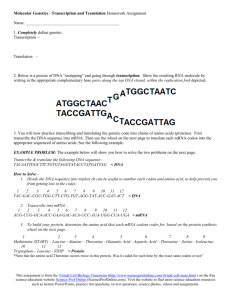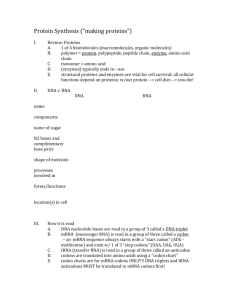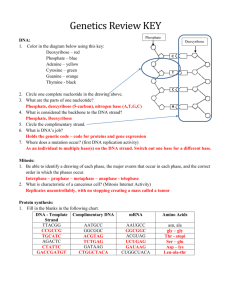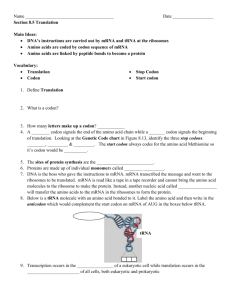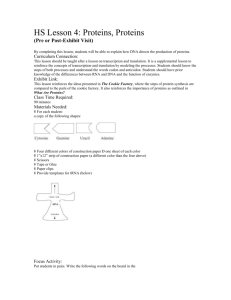Biology 11 – Evolution Lesson 9 – Genetics Review
advertisement
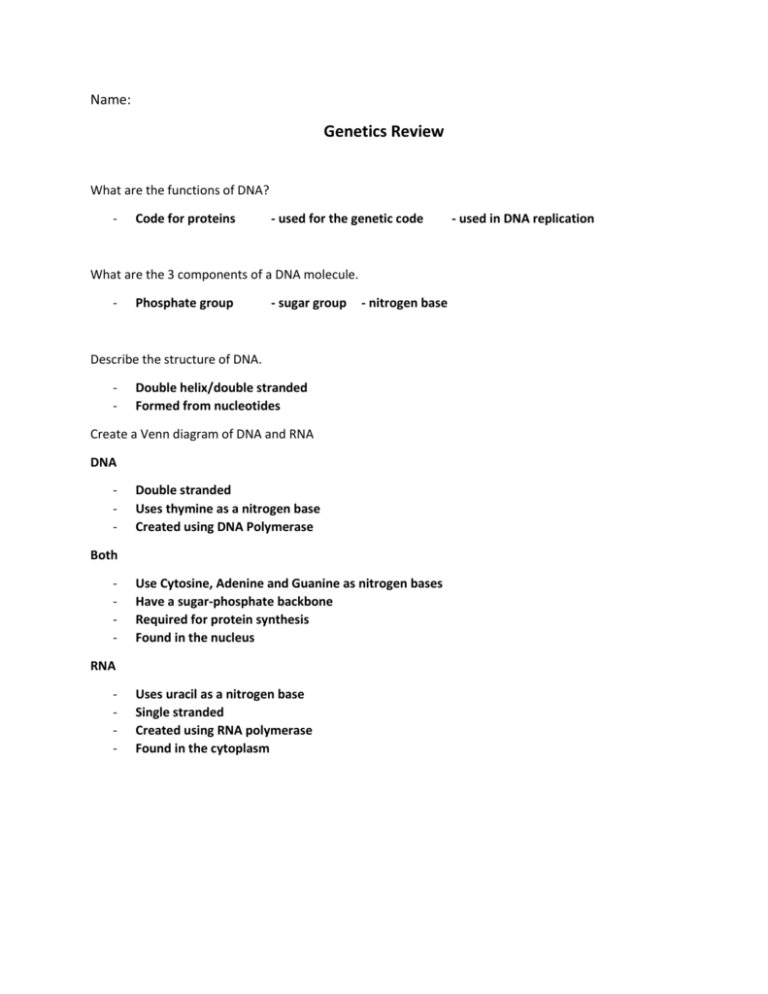
Name: Genetics Review What are the functions of DNA? - Code for proteins - used for the genetic code What are the 3 components of a DNA molecule. - Phosphate group - sugar group - nitrogen base Describe the structure of DNA. - Double helix/double stranded Formed from nucleotides Create a Venn diagram of DNA and RNA DNA - Double stranded Uses thymine as a nitrogen base Created using DNA Polymerase Both - Use Cytosine, Adenine and Guanine as nitrogen bases Have a sugar-phosphate backbone Required for protein synthesis Found in the nucleus RNA - Uses uracil as a nitrogen base Single stranded Created using RNA polymerase Found in the cytoplasm - used in DNA replication Compare and contrast a codon and an anticodon. Compare - Contrast - Both are a set of 3 nucleotides They are complementary base pairs of each other Both use A, U, C, G as nitrogen bases - codon is on a mRNA strand, anticodon is on a tRNA strand - codon is coded by the DNA, Anticodon ‘brings” the amino acid What is the function of tRNA? The anticodon of the tRNA complementary base pairs with the codon of the mRNA to bring the corresponding amino acid. tRNA plays an important part in protein synthesis. What might be the implications if the codon for the initiator protein was mutated to code for tyrosine instead. No initiator codon means that the process of translation will not begin. There is no codon to begin creating the protein, therefore the protein will not be made. This may have a large effect in the cell depending on what the protein is meant for. It could cause a change in function or stop the function of something that is important to the cell or organism. Describe the process of protein synthesis. Transcription – DNA unwinds so that mRNA can be created using the DNA template strand. This occurs using complementary base pairing. After the mRNA strand has been completed, it detaches from the DNA and is able to leave the nucleus. Translation – a ribosome attaches to the mRNA and begins to “read” it. Each set of 3 nucleotides on the mRNA, called a codon, will code for a certain amino acid. A tRNA molecule then uses its anticodon to complementary base pair to the mRNA codon. This tRNA will bring an attached corresponding amino acid. The ribosome links these amino acids together until it come across a “stop” codon. It will then release the amino acids as a newly formed protein chain. What would be the genotypes of offspring if both parents were heterozygous (Yy)? Create a Punnett square. Y y Y YY Yy y Yy yy genotypes = YY, Yy, yy If in the above question, if Y represented brown hair and y represented red hair, what would be the phenotypes of the offspring? YY – brown hair Yy – brown hair yy – red hair Relate alleles to chromosomes. A chromosome is a set of genetic material, an allele is a code for a specific trait (eg. Allele for eye colour) Each person has 2 chromosomes. Each chromosome will contain an allele for the same trait, but the actual gene may be different. Eg. Both chromosomes will have an allele for eye colour, but one chromosome may have the gene for blue eyes, and the other chromosome may have the gene for brown eyes. Describe Gregor Mendel’s experiment. Gregor Mendel experimented with cross pollination in pea plants. To ensure that self-fertilization did not take place, he removed the sex organs from the pea plants. He then pollenated each plant by hand. He then studied the phenotypes of the offspring. This led to advancement in ideas on hereditary and how genes are passed on from parents to offspring.



